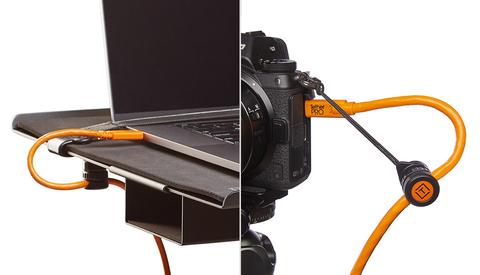
Common Camera Tethering Issues and How to Fix Them
Tethering is an essential tool for headshot photographers, providing seamless integration between your camera and computer for immediate image review. It’s a game-changer when coaching and directing clients toward that perfect expression. However, tethering can occasionally present challenges, such as disconnections or communication failures, that disrupt your workflow.
In this guide, we’ll explore common tethering issues and offer solutions to help optimize your setup. But first, let’s discuss the recommended gear that can enhance your tethering experience and minimize connection problems.
Recommended Gear for Tethering
For a smooth tethering experience, Capture One and Tether Tools products are essential. These tools are integral to Peter Hurley’s workflow, and nearly every Headshot Crew Associate photographer uses them for tethering.
Capture One
Capture One is the preferred software for tethering, offering unmatched stability and advanced features. It ensures consistent communication between your camera and computer, even during demanding shoots. Its live preview functionality lets photographers and clients view images in real-time, enabling quick adjustments. Additionally, Capture One’s powerful post-processing tools make it an all-in-one solution for tethering and editing.
Tether Tools
Tether Tools offers an extensive selection of premium products designed to solve common tethering challenges. Their high-quality cables ensure stable connections over longer distances, while the innovative Lever Lock keeps cables securely in place, preventing disconnections. These products are specifically designed to tackle issues such as signal loss, cable misalignment, and other common tethering disruptions, ensuring a smooth and reliable workflow.
Common Causes of Tethering Issues and Recommended Solutions
Signal Loss Along the Cable
Signal loss is a frequent cause of tethering issues. Tethering requires a higher signal quality than regular USB use, and even a small drop in signal strength can lead to communication failures. Low-quality cables simply cannot provide the necessary reliability.
Solution
- Use high-quality cables designed for tethering.
- We recommend Tether Tools products, like the TetherBoost Pro Core Controller, to stabilize connections over longer distances.
Loose or Misaligned Connections
Even slight movements or misalignments in the cable connection can cause tethering to drop. This issue often occurs when the computer and camera fail to identify each other due to an insecure connection.
Solution
- Use the Tether Tools Lever Lock to ensure the cable is securely connected to the camera port, preventing accidental disconnections.
- Consider using cable management solutions to prevent strain and misalignment.
Software Interference
Other programs can interfere with the tethering session. While Capture One runs smoothly on its own, camera manufacturer software may auto-launch when a camera is detected, causing interruptions in the tethering process.
Solution
- Disable auto-launching of third-party or manufacturer software.
- Ensure that only Capture One is running for tethering.
Worn USB Ports
With frequent use, the USB ports on your camera can loosen, leading to intermittent connections. This can cause the tethering session to repeatedly disconnect and reconnect.
Solution
- If your camera's USB port is worn, contact the manufacturer for a port replacement. While this is cheaper than replacing the entire camera body, it may still take several hundred dollars and time without that camera.
USB Compatibility Issues
Outdated cables or ports that don’t meet modern USB standards can result in slower or unstable tethering connections.
Solution
- Ensure that both your cables and computer ports meet USB 3.0 or higher standards for faster and more reliable data transfer.
- For more information on USB standards, refer to the USB Connector Guide.
Troubleshooting Tethering with Capture One
If you encounter tethering issues while using Capture One, follow these steps:
1. Check Camera and Computer Settings
- Ensure both the camera and computer are awake and not in sleep mode.
- Verify that the camera’s USB mode is set to "PC" or "Tethered" as required by Capture One.
2. Reconnect Devices
If Capture One disconnects, follow these steps in order:
- Turn the camera off and back on.
- Unplug and reconnect the tether cable from both the computer and camera.
- Try switching USB ports on your computer.
- Remove the memory card from the camera (if present), as the camera may attempt to access the card, which can interfere with tethering.
3. Restart Capture One and Your System
- If the steps above don’t resolve the issue, quit Capture One, relaunch it, and turn the camera back on.
- As a last resort, reboot your computer.
4. Inspect the Cable and Hardware
- Look for signs of wear on the cable or camera ports. Replace the cable if necessary.
- Consider using a powered USB hub or signal booster, like the TetherBoost Pro, for longer cable runs.
5. Update Firmware and Software
- Ensure both your camera’s firmware and Capture One software are up-to-date.
Capture one has some additional useful troubleshooting steps worth checking out on their website's support page here
Conclusion
Tethering is an essential tool in the Headshot Crew photographers’ workflow, but it can sometimes present challenges like signal loss, loose connections, software interference, and worn USB ports. Fortunately, using high-quality gear from Capture One and Tether Tools can help minimize these issues, ensuring a smooth and reliable tethering experience.
With the right gear, troubleshooting steps, and knowledge, you can keep your tethering workflow running smoothly.
Have you experienced tethering issues and found a solution not listed here? Let us know in the comments below!

2 Comments
GREAT ARTICLE!
https://headshotcrew.com/post/384468
Log in or Create an account to post comments.